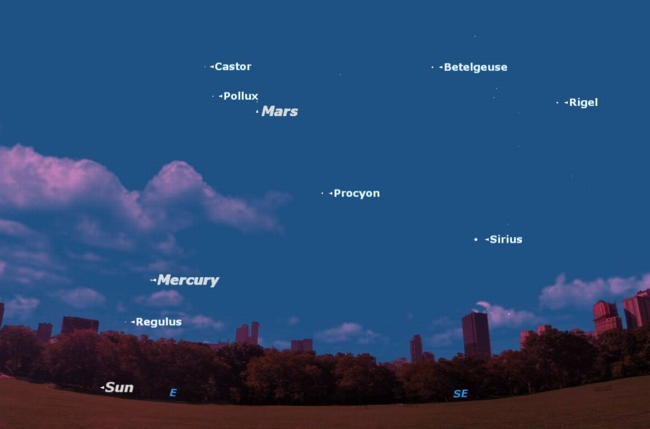Best Time to See Elusive Planet Mercury in Morning Sky Is Now

Skywatchers, take note: This week is your best opportunity of the year to see the planet Mercury as a "morning star."
Of the five planets known since antiquity, Mercury is by far the most rarely seen by the average person. In fact many serious astronomers have never seen planet Mercury, including the famous German astronomer, Johannes Kepler.
The reason why Mercury is so rarely spotted is not that it isn't bright: in fact it's generally one of the brightest objects in the night sky. Mercury's problem is that in never strays very far from the sun, so its bright light is always dimmed by the greater glory of our nearest star. [Gorgeous Mercury Photos From Messenger Mission]
Our best chances of seeing Mercury are during the periods when it is farthest from the sun, called greatest elongations. Because of the inclination of the ecliptic, the path the sun and planets take through the sky, not all elongations are equal. Only twice a year is Mercury's elongation favorable, once in the evening and once in the morning.
This week is the best morning elongation of 2011 for observers in the Northern Hemisphere. The best evening elongation this year was in late March. Good elongations in one hemisphere are usually bad ones for the other hemisphere, so the best elongations in the south this year are May 7 (morning) and November 14 (evening).
The best way to spot Mercury this week is to find an observing location with a low eastern horizon. Start looking at least half an hour before sunrise; it may help to sweep the horizon with binoculars.
The sky map of Mercury here gives you some guideposts to finding the hard-to-spot planet.
Get the Space.com Newsletter
Breaking space news, the latest updates on rocket launches, skywatching events and more!
The predawn sky is ablaze with bright, first magnitude stars: Sirius, Procyon, Betelgeuse and Rigel in Orion, Castor and Pollux in Gemini, and Regulus in Leo. Mars is now shining brightly right alongside Castor and Pollux, forming a distinctive triangle which can guide you straight to Mercury below them.
If you point a telescope at Mercury, you won't see very much, because Mercury is very small and close to the horizon, where the air is most turbulent, causing light to blur. Follow Mercury with your telescope as it gets higher in the sky, and the image will gradually improve, as Mercury rises above the turbulence. This is the secret for getting the best telescopic views of Mercury: find it in twilight, then follow it as it rises.
Over the next week, the relationship of these bright objects will change. Because of the Earth's movement around the sun, the stars will all shift upward and to the right, while the two planets will move downward and to the left.
Notice that this puts Mercury and Regulus on a "collision course." Next Friday morning, Sept. 9, there will be a conjunction between Mercury and Regulus. These two objects will then fit together comfortably in the eyepiece of most small telescopes.
This article was provided to SPACE.com by Starry Night Education, the leader in space science curriculum solutions. Follow Starry Night on Twitter @StarryNightEdu.
Join our Space Forums to keep talking space on the latest missions, night sky and more! And if you have a news tip, correction or comment, let us know at: community@space.com.

Geoff Gaherty was Space.com's Night Sky columnist and in partnership with Starry Night software and a dedicated amateur astronomer who sought to share the wonders of the night sky with the world. Based in Canada, Geoff studied mathematics and physics at McGill University and earned a Ph.D. in anthropology from the University of Toronto, all while pursuing a passion for the night sky and serving as an astronomy communicator. He credited a partial solar eclipse observed in 1946 (at age 5) and his 1957 sighting of the Comet Arend-Roland as a teenager for sparking his interest in amateur astronomy. In 2008, Geoff won the Chant Medal from the Royal Astronomical Society of Canada, an award given to a Canadian amateur astronomer in recognition of their lifetime achievements. Sadly, Geoff passed away July 7, 2016 due to complications from a kidney transplant, but his legacy continues at Starry Night.










